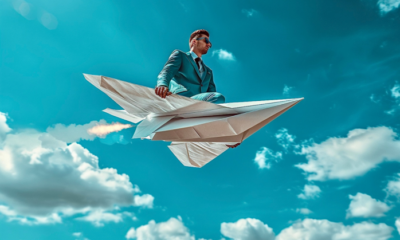Success Advice
3 Step Method to Elevate Your Leadership Through Listening
Listening connects us to others and builds relationships

Listening connects us to others and builds relationships. As clinical psychologist Dr. Henry Cloud noted: “When we are emotionally and relationally connected to others, stress levels in the brain diminish. Put simply, relationships change brain chemistry.”
In our workplaces, creating these bonds requires listening with empathy: the ability to imagine and understand others’ experiences. Carl Rogers, one of the most influential psychologists of the 20th century, used the phrase “empathetic understanding” to describe our capability to understand other people’s thoughts, feelings, and struggles.
As leaders, there’s no doubt we’re willing to listen empathetically. But how do we ensure we’re doing so effectively?
A leader’s guide to listening with empathy
Recent research has shown that there’s a proven model leaders can turn to. It’s called active-empathic listening (AEL), and it builds upon the work of Carl Rogers. When employees work with leaders who practice AEL, they report being more satisfied with their work and experience higher overall well-being.
The first step is sensing – This means being completely attentive and involved in the moment. Sensing is being fully present with your heart, your mind, and your body. It’s positioning yourself to show the other person you’re sensitive to what they’re saying. You listen to what’s being said—and what’s left unsaid.
You can accomplish this by:
- Moving away from your desk and sitting with the person in an approachable setting.
- Putting away your phone.
- Asking your administrative assistant, if you have one, to hold all calls or other interruptions.
- Giving the other person your undivided attention.
The second step is processing – This is any attempt on your part to reassure the other person that you are, in fact, listening deeply. You may share direct assurances that you’ll remember what the person says.
You can accomplish this in the following ways:
- Provide reassurances, such as: “I want to make sure I understand you fully.”
- Write down notes to show the other person you’re present and working to remember their message.
- Check for meaning by saying, “Tell me more about what you mean when you said….”
- Acknowledge—and speak out loud—the points of agreement and disagreement between you and the other person: “I see three areas where we seem to agree and one area in which we have a disagreement. What do you think?”
All of these behaviors are designed to show the other person that you’re listening deeply.
The third step is responding – Here, you use your communication skills to acknowledge the other person’s ideas. Responding involves behaviors such as nodding or leaning in. More importantly, it includes actions that demonstrate understanding.
You can achieve this by doing the following:
- Ask direct questions to probe and check for understanding: “Tell me more about what this means from your perspective.”
- Restate what the other person has said. For instance, you might say, “If I heard you correctly, you’re having a difficult time at work. You feel lost about your role, and you need clearer expectations. I can understand how this would be challenging. I think I can help.”
“Listening is an art that requires attention over talent, spirit over ego, others over self.” – Dean Jackson
Listening with empathy transforms relationships
Listening with empathy improves all relationships, from professional associations to close family connections. In a recent interview we conducted for a project on communication and happiness, Amare, a local business leader, shared a story about a powerful moment between herself and a family member.
“I had a breakthrough with a family member recently,” Amare said. “For years, I’d tried to let the past be the past. I thought I’d forgiven this person, but I realized I hadn’t.” She took a moment to collect her thoughts.
“I was still angry and bitter. I couldn’t let go. I couldn’t say, ‘OK, I forgive you.’ I wasn’t able to listen to what this person was saying because I was always on the other end thinking, ‘Well, this is what you did to me,’” she said with force.
Then, Amare made an intentional shift. She changed her mindset as a listener. She tried to see, hear, and feel the experience.
Amare told the other person, “OK, I’m going to let you tell me. I’m going to take my opinions and my preconceived ideas about what I think you think, and I’m just going to listen to you.”
As she listened, so did her family member.
Amare explained that she was finally able to share her honest feelings: “I was completely honest, but not in a way to hurt her, but saying this is truly how I feel.”
And then the magic happened. Her family member reacted, “Oh, I get it.”
“It was the first time she ever really heard me [and] it was the first time I was really able to hear her,” Amare said with relief.
“From that time forward,” Amare explained, “our relationship has really changed and evolved, and I don’t feel that anger and bitterness anymore. It’s gone. It feels so good not to be carrying that around, not to have that on my shoulders anymore.”
When people listen to one another more deeply, they become more connected. They transcend their perceived differences. “Real communication,” as Carl Rogers explained, “occurs when we listen with understanding. When we listen deeply.”
Business
If Your Business Internet Keeps Letting You Down, Read This
From smoother operations to better security, dedicated internet access is quietly powering today’s high-performing businesses.

Today, a dependable internet service is the bedrock for uninterrupted business operations. Many organizations rely on stable online connections for communication, data transfer, and customer interaction. (more…)
Did You Know
How Skilled Migrants Are Building Successful Careers After Moving Countries
Behind every successful skilled migrant career is a mix of resilience, strategy, and navigating systems built for locals.

Moving to a new country for work is exciting, but it can also be unnerving. Skilled migrants leave behind familiar systems, networks, and support to pursue better job opportunities and a better future for their families. (more…)
Life
10 Research-Backed Steps to Create Real Change This New Year
This New Year could finally be the one where you break old patterns and create real, lasting change.

Every New Year, we make plans and set goals, but often repeat old patterns. (more…)
Change Your Mindset
The Silent Skill That Makes People Respect You Instantly
What truly earns respect and why most people go about it the wrong way

Everybody craves respect but not everyone earns it. Some people believe that a title, years of experience, or a position of authority automatically entitles them to respect. (more…)
-

 Health & Fitness1 week ago
Health & Fitness1 week agoWhat Minimalism Actually Means for Your Wellness Choices
-

 Did You Know1 week ago
Did You Know1 week agoWhy Most Online Courses Fail and How to Fix Them
-

 Business1 week ago
Business1 week agoIf Your Business Internet Keeps Letting You Down, Read This
-

 News4 days ago
News4 days agoBrandon Willington Builds 7-Figure Business by Ignoring Almost Everything

























